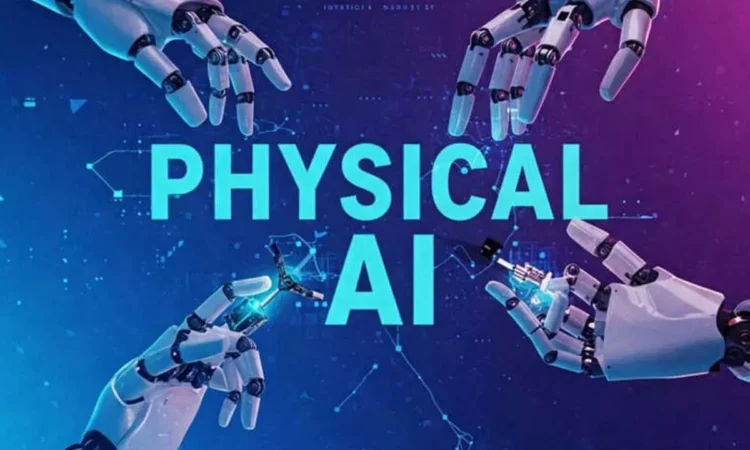The Chakravyuha, a complex battlefield formation from the Mahabharata, symbolizes a dynamic intelligence that adapts to enemy movements. Today, this concept parallels the emerging realm of Physical AI, where machines, systems, and networks interact intelligently within physical environments. Traditionally, AI was confined to screens, performing tasks like text prediction and data analysis, but in 2025, AI is breaking free from its digital confines and engaging with the physical world. This transition from digital intelligence to embodied intelligence marks a significant advancement akin to the internet’s arrival. Physical AI combines intelligence and motion, allowing machines to navigate complex spaces, recognize and manipulate objects, maintain balance, and adapt fluidly, much like living beings.
The driving force behind this transformation includes large-scale reinforcement learning, affordable high-fidelity sensors, and versatile AI models trained on various data types. For the first time, machines are not merely executing commands; they are beginning to comprehend their environments and respond accordingly. 2025 is shaping up to be a pivotal year for technology, fueled by a convergence of factors. Models of general physical intelligence, similar to how GPT revolutionized text generation, are equipping machines with universal motor skills, enabling them to learn and adapt across diverse settings. Concurrently, hardware like robotic arms, drones, and autonomous vehicles has become more affordable, allowing companies to deploy multiple units instead of merely prototypes.
Enhanced camera technology and vision systems are providing machines with a human-like awareness of their surroundings, while governments in countries like India, the US, Japan, and the EU are establishing clearer safety regulations for autonomous systems. This alignment of intelligence, affordability, and regulatory clarity is propelling Physical AI from experimental phases into mainstream application. Physical AI is transforming various industries significantly. In defense and security, autonomous drones and robotic patrols are evolving operational strategies. In healthcare, AI is facilitating surgical procedures and aiding in patient transport. Manufacturing is witnessing the rise of adaptable robotic co-workers capable of handling diverse tasks. The retail and warehousing sectors are rapidly adopting autonomous systems for inventory management and delivery.
In mobility, autonomous vehicles and dynamic logistics are becoming more prevalent. Smart cities are leveraging robotic inspections and AI-driven disaster responses. This transformation is not isolated to a single sector; it is an all-encompassing evolution across multiple industries. However, Physical AI also faces challenges distinct from its digital counterpart. Training robots in real-world scenarios is often slow and costly due to the need for repeated interactions constrained by physical laws. Solutions such as simulations and synthetic data are being employed to model real-world physics, allowing robots to practice safely and efficiently. The unpredictable nature of environments requires the development of sophisticated embodied AI models capable of integrating various principles to reliably manipulate objects.
Limitations in hardware are being addressed through advancements in sensors and real-time processing capabilities. Furthermore, techniques like meta-learning are enabling robots to transfer skills across different environments while adhering to the laws of physics. The market potential for Physical AI is rapidly becoming a reality, poised to emerge as one of the largest cross-sector opportunities in the coming decade. Projections suggest that the global AI robotics market could surpass $120 billion by 2034, with an annual growth rate of approximately 18-20 percent. Additionally, the supporting infrastructure for Physical AI, including simulation platforms and synthetic data, is expected to reach nearly $375-380 billion by 2034, highlighting the necessity of creating safe and efficient training environments.
The broader robotics market, encompassing industrial, service, and collaborative robots, is predicted to reach $185 billion by 2030, with AI increasingly integrated into these sectors. Leading companies in this rapidly evolving field include NVIDIA, which provides training platforms, Microsoft with its cloud robotics, and Google DeepMind advancing embodied AI research. Industrial giants are also enhancing traditional automation with AI. Next-generation companies are redefining machine capabilities, while logistics innovators are transforming supply chains with intelligent robotic fleets. In defense, systems are being developed that can adapt to complex environments. The focus now extends beyond merely creating smarter machines; it is about developing systems that can learn and operate alongside humans safely, heralding the era of embodied intelligence.
As the world reorganizes around this new intelligence, 2025 marks the year machines transitioned to being physical partners rather than just digital tools. This change is both structural and irreversible, symbolized by the dynamic nature of the Chakravyuha. The environment is now responsive and adaptable, challenging those who rely on outdated methods and processes. Early adopters who embrace this new landscape will shape the next decade as the future begins to move, not just be calculated.


